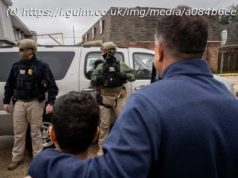It’s not possible to eliminate all risks from modern life—but airlines and regulators work hard to reduce them after each new incident, anyway.
Modern life is full of potentially terrifying “what if?” possibilities. What if a pharmacist decided to substitute morphine pills or strychnine for the next prescription you pick up? What if a school-bus driver decided to swing the wheel, and plow a full load of children head-on into incoming traffic, or off an overpass?
What if a FedEx or UPS courier decided to deliver a box full of explosives, or anthrax spores, to an office building, rather than business supplies? What if a disturbed student, teacher, or parent walked into a public school and opened fire on everyone in sight?
The last possibility is a reminder that there are risks some societies will define as acceptable. All the rest illustrate the reality that our lives hang by threads that someone else could decide to cut. The ability to inflict harm, whether intentionally or accidentally, rises more or less in pace with the technological complexity and interdependence of modern life.
Every modern city dweller depends for daily well-being and even survival on systems that make up the hard and soft infrastructure of society—water, power, sanitation, public health, and on down the list of services no one notices until something goes wrong. Most are run by people we don’t know, whose competence and good intentions we have no choice but to take for granted. As for people determined to do harm—the pharmacist who wants to poison customers, the bus driver intent on suicide—the only absolute protection would be surveillance and regimentation on a draconian scale. (Want to avoid the risk that any bus driver, ever, could do something rash? Send them all through full FBI criminal-background checks, plus psychological testing, and then staff every bus with both a driver and a co-driver, each to keep an eye on the other. Any school system could do this. None that I’m aware of does, since it would price bus service out of the realm of practicality.)
Thus sane approaches to security have been careful to set the goal of reducing risks, rather than eliminating them. The first is possible, and it naturally leads to discussions of cost, practicality, and the tradeoffs between security and liberty. The second is in most cases impossible, and it naturally invites “security theater”-style posturing in fending off threats, and “How could this have happened???” over-reaction when something inevitably goes wrong. (For more of the Atlantic ’s case against security theater, especially involving the early years of the TSA, see pieces by Jeffrey Goldberg here, and here, and by me here and here .)
So we come to the bizarre, frightening, and tragic episode on Friday night in Seattle, in which a ground-staff baggage employee of a regional airline got into an empty twin-engine turboprop, started it up and took off without permission, flew dramatic aerobatic maneuvers over Puget Sound, and then crashed on an island off Tacoma, killing himself in an apparent suicide.
Bizarre, frightening, and tragic this certainly was. Was it a sign of an alarming failure in security practices, and some press accounts immediately asserted? (For instance, from the UK’s Telegraph, soon after the event: “It has raised fundamental questions about airline security at America’s major airports after the mechanic was able to board the plane, taxi onto the runway and take off without being stopped. Aviation experts questioned what the authorities would have been able to do if the pilot was determined to fly the plane into a city rather than do loop-the-loops.”
Maybe this will be the appropriate response when more facts are known. For the moment, as is usually the case with aviation disasters, many of the most important questions about what happened are impossible to answer right away. Here are some of the aviation details, known and still puzzling, and then my hypothesis as to how this could have happened. (I trained for and got my instrument rating at Boeing Field, in Seattle, in 1999 and flew frequently in Seattle airspace when I lived there in 1999 and 2000.)
Could this have been much worse? Clearly it could have. If a ground-crew member had been purposeful, better trained, and able to haul explosives or other damaging cargo with him onto the plane, he could have reached downtown Seattle before the F-15s got to him. That’s a plainly possible “What if?”, like the strychnine, anthrax, and school-bus examples with which I began. And even if the resulting toll were “merely” comparable to that of a large-scale American gun massacre—it could not have been comparable to the 9/11 attacks, since the plane is so much smaller and carries so much less fuel—the psychological impact of airplane-borne threats is always greater than sheer numbers would indicate. (Airline travel in the U. S. is statistically about the safest thing you can do; many people are nonetheless afraid of flying)
Could it have been avoided altogether? We’ll see what the details show. As with the Germanwings crash of 2015, in which a depressed 28-year-old airline pilot deliberately flew himself and 149 other people into the ground, the easiest break-point would have been someone noticing how disturbed a staff member had become.
As for (even) greater screening and supervision of airport and airline staff members, that is sure to come. One reason North American and European airlines are now so exceptionally safe is that they view each crash, death, or even near-miss as the occasion for systematic learning and error reduction, to address the vulnerability that has just been revealed. Because decades of refinement have eliminated so many air-safety problems, the crashes that do occur tend to involve some previously underappreciated problem—for instance, the auto-pilot and crew-management issues that led Air France 447 to plunge into the Atlantic Ocean. (Think of how different this is from car-crash investigations or the stories of mass shootings, where the background factors are so familiar that most people can guess them before the full details come in.)
I hope that, when the facts are in, the response to this odd, sad incident will resemble what the aviation system usually does with its failures, rather than the way the political system often behaves.






